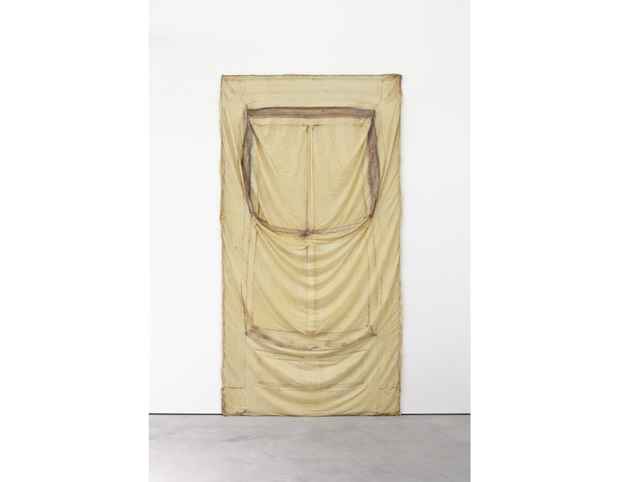Robert Overby “Persistence. Repeated”
Andrew Kreps Gallery

This event has ended.
Andrew Kreps Gallery presents Persistence. Repeated, an exhibition devoted to the work of Robert Overby (1935–1993).
This exhibition follows the travelling retrospective, Robert Overby. Works 1969–1987, which in 2014 and 2015 was staged at four European institutions: the Centre d’Art Contemporain in Geneva, the Galleria d’Arte Moderna e Contemporanea in Bergamo, the Bergen Kunsthall and Le Consortium in Dijon. Curated by Alessandro Rabottini, this survey was accompanied by the most complete publication to date on the California artist’s work.
Robert Overby: Persistence. Repeated explores the themes of referencing, copying and repetition in the artist’s work, and the way in which certain operations rooted in Overby’s profession, graphic design, were expressed on a formal and conceptual level throughout his practice. Overby was an immensely prolific artist in terms of formal results, but consistent from a thematic standpoint. He enacted a varied and eclectic ensemble of styles and techniques, while demonstrating an obstinate resistance against the very concept of “style.” Overby demonstrated great interest in the subject of time and the fragility of human existence in works that explore materials, images, and architecture in their impermanence.
Employing tools such as photography, architectural castings, and appropriation paintings, Overby consistently analyzed the concepts of originality and authorship. Through adapting the same visual information to different supports, he investigated its material nature, and the gradual loss of quality inherent in its transmission. Blue Screen Door (1971) is presented within the exhibitions in the three successive formalizations generated by the initial visual information: the architectural cast, in resin, of a door (Overby viewed the casting technique as a cross between sculpture and photography,) followed by the neon outline of that door (Blue Door Edge, 1971) and the final outcome, a canvas map that is the final trace of the original object (Blue Screen Door Map, 1972).
At the exhibition’s heart are the numerous variations of lithographs executed by Overby between 1973 and 1975. The image is a copy of Overby’s Durer Head on Fake Wood Panel (1973), which in itself is an altered copy of an isolated detail from Albrecht Dürer’s 1506 painting, Madonna with the Siskin.The motif of the virgin’s head was subjected to a series of repetitions both object based—as in the case of WAXY LADY and CARUMBA (both from 1975)—and print based—such as R.R.O.S.E. (1974) and FADING LADY (1975). CARUMBA explores the iconographic variation and ironic drift of the mechanism of appropriation, whereas R.R.O.S.E. and FADING LADY are symptomatic of formal and conceptual preoccupation with chromatic variation, and the processes of printing and repetition. Nevertheless, all these works share the same concentration on the material nature of images and of the supports that convey them, emphasizing the process of progressive deterioration that is inherent in the device of repetition.
The artist’s longstanding fascination with the works of the Old Masters also led to the series of Restoration Paintings, three of which dating from 1973 are included in the exhibition: Princess Restoration c. 1850 anon., St. Cecilia c. 1590 and Venus 1600 c. In these works, the concept of the copy is structural, as Overby purchased cheap, anonymous imitations of these works at street markets, which he then proceeded to clean and restore. Well ahead of research conducted in the late Seventies and early Eighties on the art of appropriation, here Overby not only emphasizes the ambiguity inherent in the concept of artistic originality but, in a more radical and intimate way, he considers the pictorial object a living organism that deteriorates over time and may disappear.
The concept of the image as surface information is confirmed by the two examples of Rubbing Drawings, executed in 1972 while the artist spent time in New York. These works were made in the studio of photographer Ralph Gibson, where Overby applied the Surrealists’ beloved frottage technique to architecture by placing sheets of paper on the floor, translating its texture into marks. His latex cast titled Loft Window (1971), included in the exhibition, was also taken from Gibson’s studio. The simultaneous presence of these works confirms that Overby’s exploration of processes and materials moved in an unorthodox direction, favoring instead a discussion focused on simulation and representation.
Overby’s architectural cast works, for which the artist coined the term “Baroque Minimalism,” constitute inescapable testimony within the history of postwar American art. As demonstrated by Loft Window, Corner Piece Unlimited Multiple (1973), as well as Blue Screen Door (all included in the exhibition), they are part of a current of research that, from Eva Hesse to Paul Thek, explores the transitory nature of materials within more sweeping reflections on individual sentiment and finiteness. These latex and resin mappings of space are juxtaposed with canvas works, all of which were produced in 1972. Blue Screen Door Map, Two Window Wall Map, Broken Window Map, and Corner Piece Map are canvas copies of their corresponding sculptures, constituting a meditative counterpoint to the more dramatic latex works.
Media
Schedule
from September 10, 2015 to October 31, 2015
Opening Reception on 2015-09-10 from 18:00 to 20:00